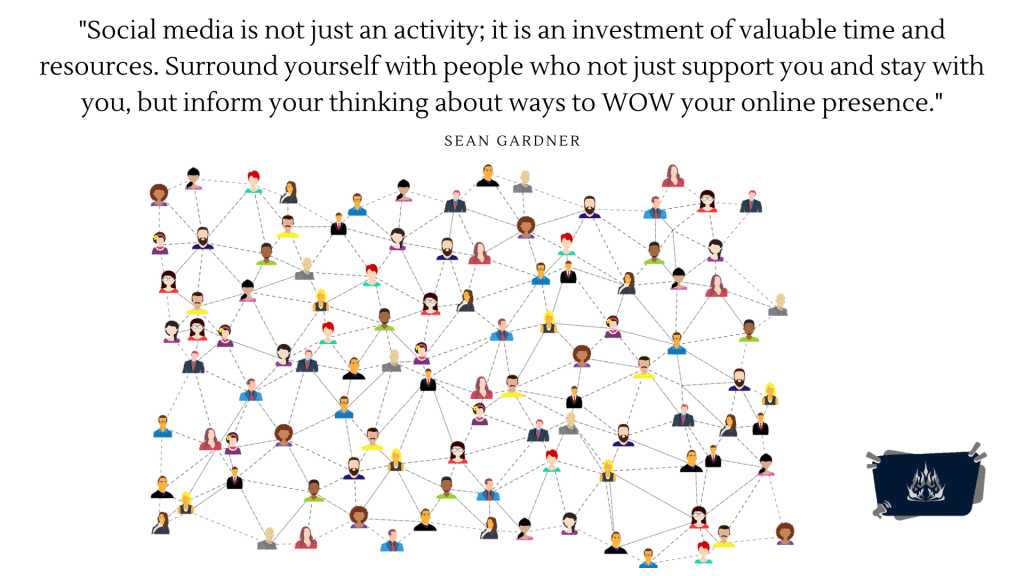How Social Media Drives Sales?
Social media is continuously evolving, offering fresh insights that help business owners and users anticipate future trends. Staying informed about the latest social media statistics and trends offers a comprehensive understanding of the social media landscape. We analyse these data gathered key social media insights from recent surveys and research to help you stay informed.
These insights reveal the dynamic nature of social media and its impact on marketing strategies, customer engagement, and sales performance. From the rise of short-form video content to the increasing importance of personalized customer interactions, the data highlights significant shifts in user behaviour and platform functionalities. By leveraging this information, businesses can fine-tune their social media strategies, capitalize on emerging trends, and maintain a competitive edge in the digital marketplace.

Topics Index
- Introduction
- The Evolution of Social Media Marketing
- Impact on Brand Awareness
- Customer Engagement and Interaction
- Targeted Advertising
- Influencer Marketing
- Sales Conversion
- Customer Feedback and Service
- Content Marketing
- Analytics and Metrics
- Challenges and Risks
- Future Trends
- Conclusion
Introduction
Definition and Brief History of Social Media
Social media refers to online platforms and applications that facilitate the creation, sharing, and interaction of content among users. Since the launch of platforms like Facebook, Twitter, and LinkedIn in the early 2000s, social media has become an integral part of daily life. By 2024, over 4.5 billion people worldwide are active social media users, a testament to its widespread adoption and influence.
Overview of Its Significance in Marketing and Sales
Social media has revolutionized how businesses approach marketing and sales. It offers unique opportunities to reach large audiences, engage with customers, and drive sales. The ability to connect with consumers on a personal level, gather data, and measure performance makes social media an invaluable tool for marketers.

The Evolution of Social Media Marketing
Early Days of Social Media Marketing
In the beginning, businesses used social media primarily to establish an online presence and engage with early adopters. Platforms like MySpace and Friendster were among the first to host brand profiles, allowing companies to post updates and interact with followers.
Major Milestones and Changes Over the Years
The introduction of Facebook Pages in 2007 marked a significant shift, enabling businesses to create dedicated profiles for marketing purposes. Twitter’s rise in popularity allowed for real-time customer interaction, while Instagram’s launch in 2010 emphasized visual content. By 2020, TikTok emerged as a major player, highlighting the importance of video content.
Impact on Brand Awareness
Statistics on Brand Reach Through Social Media
Social media dramatically enhances brand visibility. According to a 2023 report by Statista, 91% of businesses use social media for marketing, with 80% of marketers citing increased exposure as a primary benefit. Facebook alone boasts over 2.8 billion monthly active users, offering unparalleled reach. According to Sprout Social 55% of consumers discover brands for the first time
Case Studies of Successful Brand Awareness Campaigns
Campaigns like Coca-Cola’s “Share a Coke” and Nike’s “Just Do It” have leveraged social media to create viral moments. These campaigns generated millions of interactions, demonstrating the power of social media in amplifying brand messages.
Customer Engagement and Interaction
How Social Media Facilitates Direct Communication
Social media breaks down barriers between brands and consumers. Platforms like Twitter and Instagram enable direct messaging and real-time responses, fostering a sense of community and trust.
Engagement Metrics and Their Importance
Metrics such as likes, comments, shares, and retweets are vital indicators of consumer engagement. High engagement rates often correlate with increased brand loyalty and customer satisfaction. A study by Sprout Social found that 64% of consumers want brands to connect with them on social media.
Targeted Advertising
Benefits of Targeted Ads on Social Media
Targeted advertising allows businesses to reach specific demographics based on user data. This precision increases ad effectiveness and ROI. Facebook’s ad platform, for instance, enables targeting by age, location, interests, and behaviors.
Examples and Statistics on Ad Effectiveness
According to Hootsuite, social media ads have an average click-through rate (CTR) of 1.3%. Instagram ads, particularly in Stories, have proven highly effective, with some brands reporting conversion rates as high as 10%.
Influencer Marketing
Role of Influencers in Marketing Strategies
Influencers, with their substantial followings and trusted voices, are key players in social media marketing. Collaborations with influencers can significantly boost brand credibility and reach.
In 2019, a study published in the Journal of Marketing revealed that three-quarters (75%) of marketers incorporated social media influencers into their promotional efforts to spark word-of-mouth discussions and bolster brand recognition. This form of marketing, known as influencer marketing, proves highly effective in fostering genuine engagement with online audiences when perceived as authentic.
Statistics on Influencer Marketing ROI
A survey by Influencer Marketing Hub reported that businesses earn an average of $5.20 for every $1 spent on influencer marketing. Furthermore, 63% of marketers plan to increase their influencer marketing budgets in the coming years.
Sales Conversion
How Social Media Drives Sales
Social media platforms are increasingly equipped with features designed to facilitate sales, such as Instagram Shopping and Facebook Marketplace. These tools streamline the purchasing process, making it easier for consumers to buy directly from social media.
In today’s digital landscape, social media has become more than just a platform for connecting with friends; it’s a powerful tool for driving sales. Through targeted advertising, influencer collaborations, and engaging content, businesses can reach their target audience with precision and impact. Social media allows for personalized interactions with potential customers, fostering trust and loyalty. By showcasing products or services in an authentic and visually appealing manner, brands can capture the attention of users scrolling through their feeds. Moreover, social proof in the form of likes, shares, and positive comments can significantly influence purchasing decisions.
Case Studies and Statistics on Social Media Conversion Rates
A Shopify study found that 85% of orders from social media come from Facebook, while Instagram accounts for 13%. Another research from MarketWatch shows the same study highlighted that brands with a strong social media presence see up to a 45% higher conversion rate.

Customer Feedback and Service
Role of Social Media in Customer Support
Social media serves as a vital channel for customer service. Platforms like Twitter and Facebook allow for quick resolution of issues, enhancing customer satisfaction.
Impact on Customer Satisfaction and Loyalty
Responding to customer inquiries and complaints on social media can significantly impact brand perception. According to J.D. Power, 67% of consumers have used a company’s social media site for customer service, underscoring its importance in maintaining customer loyalty.
Content Marketing
Importance of Content Creation and Sharing
High-quality content is the backbone of social media marketing. Sharing valuable, relevant content helps attract and retain a defined audience, ultimately driving profitable customer action.
Examples of Successful Content Marketing Campaigns
Brands like Red Bull and GoPro have mastered content marketing on social media. Red Bull’s extreme sports videos and GoPro’s user-generated content campaigns have garnered millions of views and shares, creating a loyal customer base.
Analytics and Metrics
Tools for Measuring Social Media Performance
Various tools, such as Google Analytics, Hootsuite, and Sprout Social, help businesses track their social media performance. These tools provide insights into audience demographics, engagement rates, and conversion metrics.
Key Metrics and Their Interpretation
Essential metrics include reach, engagement, conversion rate, and return on investment (ROI). Understanding these metrics helps businesses refine their strategies and achieve better results.
Challenges and Risks
Common Challenges in Social Media Marketing
Despite its many benefits, social media marketing presents several challenges that businesses must navigate to be successful. Frequent algorithm changes on platforms like Facebook and Instagram can significantly impact the visibility and reach of organic posts, requiring businesses to stay updated and adapt their strategies. Negative feedback is another challenge, as social media provides a public forum where dissatisfied customers can voice their complaints, potentially damaging a brand’s reputation. Additionally, managing multiple platforms with unique content requirements and maintaining consistent engagement can be resource-intensive and time-consuming.
Strategies to Mitigate Risks
To mitigate these risks, businesses should adopt a proactive and strategic approach. Regularly monitoring social media platforms for algorithm changes, trending topics, and customer feedback is essential. Utilizing social media management tools can help track performance metrics and inform strategy adjustments. Maintaining a consistent brand voice across all platforms fosters trust and loyalty among followers, while a crisis management plan ensures preparedness for handling negative feedback or PR issues.
Developing a diversified content strategy that includes various content types tailored to each platform’s strengths can keep followers engaged and relevant. Investing in ongoing training for social media teams ensures they stay current with trends and best practices. Additionally, ensuring compliance with data privacy regulations and leveraging analytics to gain insights into content performance are crucial steps. By addressing these challenges with proactive strategies, businesses can effectively navigate the complexities of social media marketing and achieve their marketing and sales objectives.
Conclusion
Summary of Key Points
Social media has fundamentally transformed marketing and sales, offering unprecedented opportunities for brand awareness, customer engagement, targeted advertising, and sales conversion. Despite challenges, its benefits are undeniable.
Final Thoughts on the Impact of Social Media on Marketing and Sales
As social media continues to evolve, its impact on marketing and sales will only grow. Businesses that adapt to these changes and leverage the power of social media will thrive in this dynamic digital landscape.

